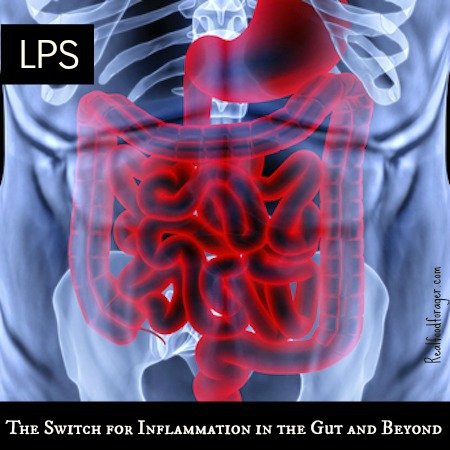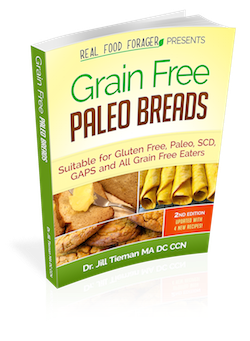LPS (short for lipopolysaccharide) is a major component of the outer membrane of some bacteria. Made of fats (lipids) and sugar, this compound is both structural and protective to normally benign bacteria. However, when released into the bloodstream, LPS is a potent endotoxin (coming from within) and drives a sudden and acute inflammatory reaction.
LPS has long been used in research to induce inflammatory responses in mammals in order to study them. Many conditions are induced in the laboratory by using LPS, such as Alzheimer’s, MS, IBD, diabetes, cardiovascular disease, Parkinson’s, depression, autism and many other autoimmune diseases.
It is also known that many people with these conditions carry elevated LPS markers.
LPS should not be in the bloodstream at all. However, it has been found that if the lining of the intestine is leaky – that is, the normally tight junctions are compromised – LPS can get into the bloodstream and cause serious damage.
This indicates that leaky gut not only creates inflammation through the food allergy mechanism, but also allows the potent and damaging molecule called LPS into the blood.
A Major Breakthrough in Research
Importantly, elevated LPS in the blood is indicative of not only systemic inflammation, but intestinal permeability as well.
Previously, researchers for brain disorders, for instance, have looked to the brain for answers. Now they have evidence that the intestine is the place to look as the root cause of many disorders and diseases.
For instance, this study published in the Journal of Neuroinflammation showed that injections of LPS into the abdomen of mice stimulated inflammation in the brain, memory loss and increased beta-amyloid in the brain (implicated in Alzheimer’s disease).
LPS is normally found in the gut because it is part of the bacterial membranes. But it should not be in the bloodstream where it can create extraordinary destruction.
Additionally, in this study published in PLoS One found that the Parkinson’s patients has much greater intestinal permeability than controls and that this was correlated with increased LPS in the blood. Additionally, they found that intestinal permeability is an early marker of Parkinson’s disease and that further research may target early diagnosis and therapeutics.
A New Organ called the Microbiome
The most exciting research involves the newly identified organ we have called the microbiome. It’s actually mind boggling on how much research is going on involving this. Universities are scrambling to get studies underway because this research has so much potential to get to the actual cause of so many debilitating diseases.
A recently published study in the journal Cell Host & Microbes, explored the question of whether it is genetics or diet that drives changes to the gut microbiome.
The researchers found that diet was the more important driver of microbiome diversity – not genetics.
Furthermore, when the mice were reverted back to their original diets, the majority of their microbiome reverted back as well, although this did not happen to all the subjects.
Additionally, they found that it took only 3 days to change the community of microbes in the gut and that this was independent of genetics.
The researchers concluded that,
These new results emphasize that, unlike a mammalian genome — which is relatively constant — the microbial genomes that comprise the gut microbiome are relatively plastic… It may someday be possible to design diets that shape the gut microbiome in a way that is therapeutically beneficial. The good news is that the microbial response to a given diet may be similar for many people’s microbial communities, suggesting that we might not need to tailor interventions differently for every single person. (source)
Can We Get Bacteria From Fermented Foods?
It is commonly thought that eating fermented foods will provide trillions of beneficial bacterial cells. However, when you eat fermented foods, the bacteria that is in the fermented foods is not going into your digestive system.
The benefit is from the actual ferment — the breakdown of the nutrients in the food and the nutrients that are produced as a result of the ferment. These bacterial peptides and peptidoglycans can be very healing for the gut and may support the bacteria that are part of your microbiome.
You may have thought that fermented foods provide the beneficial bacteria, but these bacteria die as they travel through the digestive system and just pass through.
Diversity is the Key
The gut is an ecosystem. We need many different strains of bacteria and we need overlap in what they do for us. In this way, if some strains die off (or are killed by outside factors such as medications) you still have other species that can do the same for you.
Bacterial diversity protects you from pathogenic species that can overtake the microbiome. Additionally, the more diverse, the more functions they can do for you.
How to Grow Your Microbiome
Instead of trying to kill off the bad bacteria, the best approach is to nourish the microbiome and support it in order to increase diversity. When the microbiome is healthy it will naturally suppress the bad bacteria.
Much like a garden, instead of using weed killer, it is more productive to encourage the good organisms in the yard and soil and these will keep out the pests.
Create the environment that favors the growth of good bacteria. Diet is critical. Sugars, processed foods and grains are pro-inflammatory and the pro-inflammatory state encourages bad bacteria (and cancer and other diseases).
Another important action is to improve the PH by eating plant based foods as well as good animal fats, animal proteins and eating a diverse array of foods. Diverse foods will encourage diversity in the bacteria.
Fermented foods play a huge role here as they give you so many nutrients that are not available through foods. Additionally, get environmental bacteria such as soil based bacteria as these bacteria provide many beneficial functions and nutrients.
Another buzz word these days is resistant starch. Many folks, notably the Drs. Jaminet in their book, The Perfect Health Diet, talk about resistant and safe starches. These include, sweet potatoes, white potatoes, tapioca, root vegetables and white rice.
According to the Drs. Sonnenberg is their new book, The Good Gut, microbiota accessible carbohydrates are the best way to nourish the microbes in the gut.
According to Dr. Permutter in his new book, Brain Maker, some of the foods that will support growth of good colonies of bacteria are, Jerusalem artichoke, jicama, dandelion greens, leeks, onions.
LPS is an indicator of intestinal inflammation. Where there is inflammation, there are pathogenic bacteria. Perhaps the most important takeaway here is that the pathogenic bacteria survive by feeding on the byproducts of inflammation (becoming a vicious cycle), yet the good bacteria survive on fermentation of fiber.
This suggests that you should eat fiber (and possibly resistant starch) to feed the good bacteria. These are all foods I love, especially jicama and leeks! What do you eat to feed your microbiome? Leave a comment and let me know!











